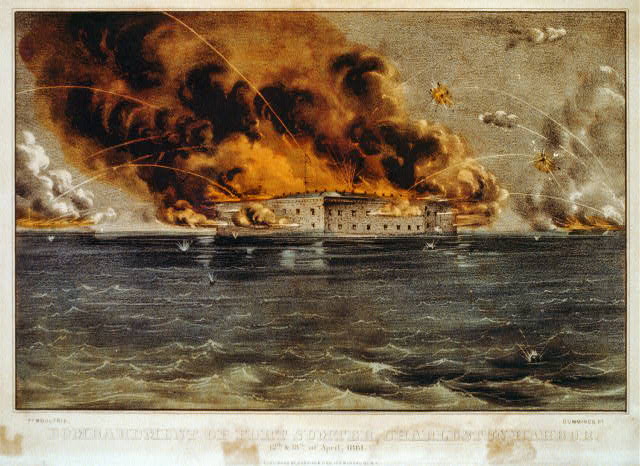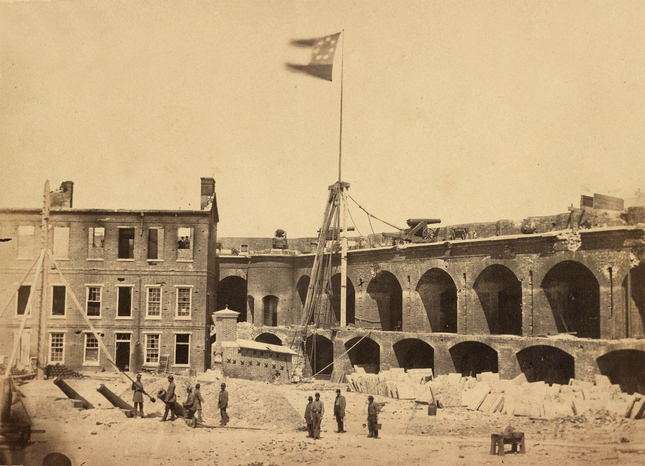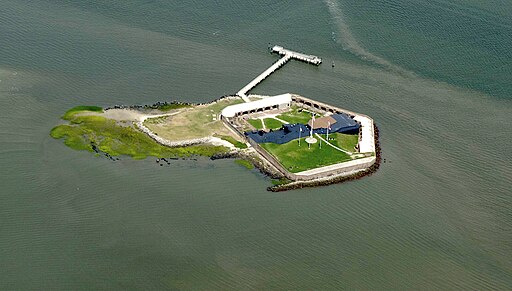
Fort Sumter is a sea fort in Charleston, South Carolina, notable for the battle, which signified the start of the American Civil War.
The Battle of Fort Sumter in 1861 was the bombardment of Fort Sumter by the South Carolina militia; the Confederate Army did not yet exist.
The United States Army returned gunfire, but the fort had been cut off from its supply lines and surrendered the next day. This battle marked the start of the American Civil War.
Fort Sumter was one of several forts planned after the War of 1812, that combined high walls and massive masonry. Work started in 1829 but was incomplete by the time that the Civil war began.
Seacoast defense was a significant concern for the United States before airplanes, as America’s enemies could only reach it from the sea. Coastal forts were an economical alternative to standing armies or a large navy.
The First Battle of Fort Sumter began on April 12, 1861, when South Carolina Militia artillery fired on the Union garrison. These were some of the first shots of the war, and many Charleston civilians in a celebratory spirit watched it.

Bombardment of Fort Sumter, Charleston Harbor: 12th & 13th of April, 1861
The Second Battle of Fort Sumter in 1863 was a failed attempt by the Union to retake the fort.
Although the fort was reduced to rubble, the Union operation was a fiasco from beginning to end due to the rivalry between the Union army and navy commanders.
Fort Sumter remained in Confederate hands until it was evacuated as General Sherman marched through South Carolina in 1865.
The fort was named after General Thomas Sumter, the Revolutionary War hero. Seventy thousand tons of granite were transported from New England to build up a sand bar in the entrance to Charleston Harbor, which the site dominates.
The fort was a five-sided brick structure, with walls five feet (1.5 m) thick, standing 50 feet (15.2 m) over the low tide mark. It was designed to house 650 men and 135 guns in three tiers of gun emplacements.
After the Civil War, Fort Sumter was in ruins. The U.S. Army restored it as a functioning military installation. The damaged walls were re-leveled to a lower height and partially rebuilt.
The third tier of gun emplacements was removed. Eleven of the original first-tier gun rooms were restored with 100-pounder muzzle-loading rifled artillery.

Confederate flag flying over Fort Sumter – April 15, 1861
A new massive concrete blockhouse-style installation was built in 1898 inside the original walls, armed with new guns.
The battery was deactivated and in 1948 the fort became Fort Sumter National Monument under the control of the National Park Service.
Highlights of Fort Sumter
- Fort Sumter Visitor Education Center
- Fort Fortifications
- Cannon Installations
- Cannon Displays
- The ferry ride to Fort Sumter
- Fort Sumter National Monument
- Fort Sumter Flag
- Fort Sumter Artifacts and Historic Photos
- Exhibits on the Events leading up to the Civil War

Fort Sumter Aerial View
Fort Sumter
- Museum: Fort Sumter
- City: Charleston
- State: South Carolina
- Country: United States
- Started: 1829
- First Battle: 1861
- Second Battle: 1863
- Type: Historic Site, Military and War Museum
- Location: 340 Concord St, Charleston, SC 29401, United States

Fort Sumter, Charleston Harbor
Fort Sumter – Map
Fort Sumter – 360 Virtual Tour
Fort Sumter – 360 Virtual Tour
Fort Sumter – 360 Virtual Tour
Fort Sumter
Museums in Charleston, South Carolina
- Gibbes Museum of Art
- Nathaniel Russell House
- Magnolia Plantation and Gardens
- Fort Sumter
Atlanta Museums
- High Museum of Art
- Atlanta History Center
- National Center for Civil and Human Rights
- William Breman Jewish Heritage Museum
- World of Coca-Cola Museum
Fort Sumter
Museums in Charlotte, North Carolina
- Carolinas Aviation Museum
- Bechtler Museum of Modern Art
- NASCAR Hall of Fame
Museums in Raleigh, Durham, and Chapel Hill, North Carolina
- North Carolina Museum of Natural Sciences
- North Carolina Museum of Art
- Historic Yates Mill County Park
- Ackland Art Museum
Fort Sumter
Montgomery Museums, Alabama
- Montgomery Museum of Fine Arts
- National Memorial for Peace and Justice
- The Legacy Museum: From Enslavement to Mass Incarceration
Birmingham Museums, Alabama
- Birmingham Museum of Art
- Barber Vintage Motorsport Museum
Fort Sumter
~~~
“Beauty will save the world.”
– Dostoevsky
~~~
Photo Credit: Clynnwersch / CC BY-SA (creativecommons.org/licenses/by-sa/4.0); Published by Currier & Ives / Public domain; Alma A. Pelot / Public domain; Dsdugan / CC BY-SA (creativecommons.org/licenses/by-sa/4.0)Methaz / CC BY-SA (creativecommons.org/licenses/by-sa/3.0)
Popular this Week








 Sponsor your Favorite Page
Sponsor your Favorite Page SEARCH Search for: Search Follow UsJoin – The JOM Membership Program
Sponsor a Masterpiece with YOUR NAME CHOICE for $5
Share this:
- Tweet
